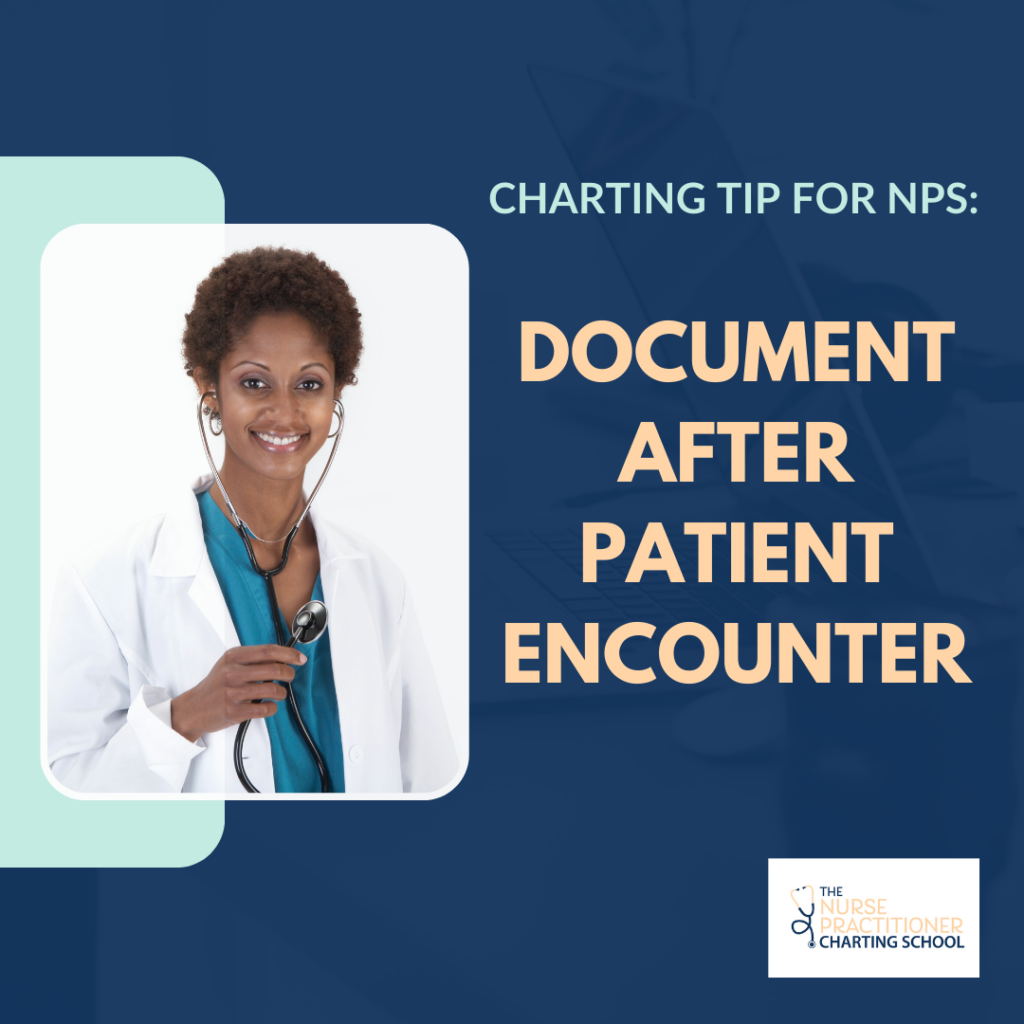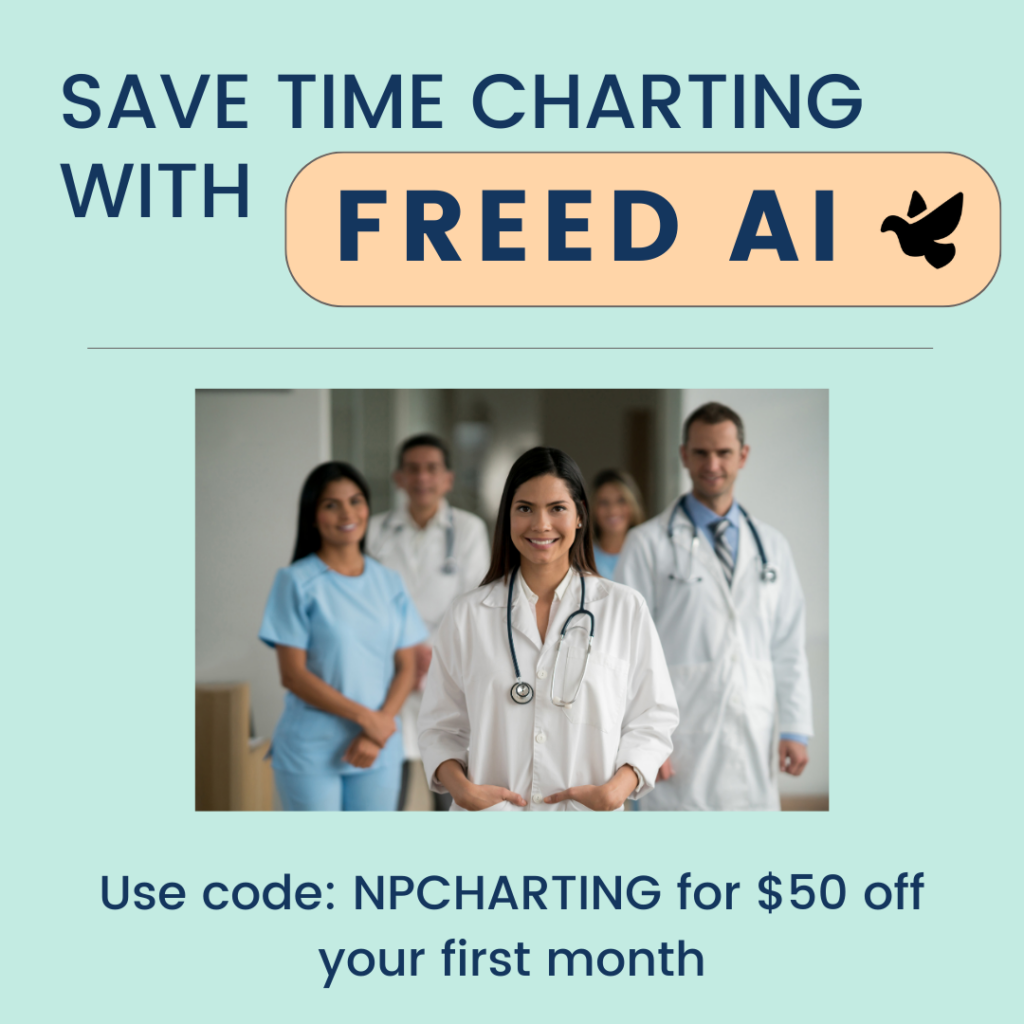Erica D the NP Charting Coach is bringing you yet another charting tip for NPs!
This charting tip for NPs is actually one of my favorites! It can have a tremendous impact on time management, productivity, and eliminating mental fatigue. This tip may not be easily implementable, but if nurse practitioners can apply it to even half of their charts it will help so much!
The charting tip for NPs I am referring to: Document after the patient encounter.
The concept of this time management tool is to sign the chart note right after the patient encounter. I’m talking like right after! As soon as you walk out of the exam room, take a few extra minutes to complete the note and get it signed!
This charting tip for NPs allows nurse practitioners to get their work done so they can STOP charting at home! We will take a look at the benefits of this charting tip for NPs and then look at how to actually implement the time saving tip!
Benefits of this charting tip for NPs
This charting tip for NPs is so helpful for many reasons. Here are a few of the benefits.
Takes less time.
Documenting right after a patient encounter takes less time for the nurse practitioner! It is much easier to chart when the information is fresh in the mind. If the APRN waits until the end of the day, it will take longer as they have to try to recall what signs and symptoms the patient had. The nurse practitioner has to remember the physical exam findings, plan of care, and medications prescribed. This is a lot to remember after a long day!
If the nurse practitioner is charting at the end of a long day or even at home, it takes longer to go back in the chart and pull information such as diagnostic findings or prescriptions sent. This charting tip for NPs eliminates this extra time with getting the charts signed.
Improves mental clarity
This charting tip for NPs dramatically improves mental clarity. Once the nurse practitioner signs off the chart note, they can clear it from their mind. With one less chart to think about, the APRN notices improved mental clarity. The nurse practitioner has the ability to move onto the next task or see the next patient. They can then put their full focus and attention to this patient without feeling bombarded by the amount of open charts.
This charting tip for NPs has a compounding effect. When the nurse practitioner can better focus on the task at hand, they can not only do a better job but also complete that task more efficiently. Improving mental clarity dramatically increases productivity and time management as a nurse practitioner.
Improves productivity
This charting tip for NPs helps nurse practitioners stay on time during their workday. When the APRN stays on time, it improves their mental clarity and overall productivity. Think about a time when you have been completely overwhelmed. How was your level of focus? Did you have a hard time getting charts signed? Where you able to focus on the next patient or did you feel mentally fatigued?
Finishing a chart note after the patient encounter helps to improve productivity throughout the day. That is why this charting tip for NPs is so powerful!
How to implement this charting tip for NPs
As I have mentioned, this is one of my favorite charting tips for NPs! When I started doing this myself I noticed the benefits right away. It took me less time to complete a chart note right after the patient encounter than if I waited till the end of the day. I was able to focus better on the task at hand and noticed improved mental clarity. I immediately became more productive and better managed my time.
But implementing this charting tip for NPs is not as easy as it looks. There are often challenges or obstacles that get in the way. There are days when everything goes as planned and days when it is complete chaos. I will share how I implement this charting tip and then discuss some pointers to implement it into your own practice!
I chose to document in the patient room. I find that it is better for my memory and can get most of the history of present illness (HPI) completed. I make sure to make lots of eye contact and practice active listening.
After I am done seeing the patient, I usually come out of the patient room and sit down at my desk. Then I will focus on that one chart note. I will proofread and clean up the HPI. I use templates so the patient’s past medical history, allergies, medications, even vital signs easily pull over into the chart note. I quickly check to make sure the parts of the Subjective portion of the chart note have pulled over.
**For more information on the format of a SOAP chart note check out this article: How to write a SOAP note.
Then I will take some time and update the physical exam portion. My templates have a “normal” physical assessment so I just have to adjust anything that was abnormal and delete the parts of the exam that I did not complete. Then I will move onto the Assessment and Plan. It usually takes me 2-5 minutes to sign off the chart note but it feels so good to have it completed!
Pro tip: If I am waiting for lab results or further need to research the treatment plan, I will place a marker at this spot and come back to it before I finish the chart note. Even if I am not able to sign off the note during the patient encounter, I can still get most of it done!
Tips to document after the patient encounter
Acknowledge the benefits.
Documenting after the patient encounter is a difficult charting tip for NPs to achieve. Many APRNs are already running behind, appointments scheduled every 15 minutes, double booked, with a waiting room full of patients. However, if you realize how beneficial this charting tip for NPs can be, it helps to implement it!
Take a look at the benefits listed above. Remember that taking 2 minutes after the patient encounter to document is much easier than taking 10-20 minutes at the end of the day. Utilizing this charting tip for NPs will help nurse practitioners STOP charting at home.
Focus on this charting tip for NPs.
The Nurse Practitioner Charting School offers several charting tips, time management hacks, info on billing & coding, and legal issues with charting. There are so many ways nurse practitioners can improve their charting!
Make it a point to focus on one thing at a time. By implementing small, attainable changes, nurse practitioners can actually achieve the charting goal they set. Once the nurse practitioners conquers one time saving tip, they can then implement another tip. This compounding effect can dramatically improve the amount of time nurse practitioners spend charting.
Adjust as needed.
Feel free to adjust this charting tip for NPs to better fit your practice! For example, if you are working in the ED as a nurse practitioner, it may be easier for you to round on 2-3 patients before you come back to your workspace to chart. If the ED is spread out it will actually take more time to see a patient and come back and document. Rounding on a few patients and then making time to update their chart notes is a great charting tip for NPs working in the ED.
This charting tip for NPs can also be helpful in an urgent care, primary care, or specialty care setting. If there are 2-3 patients checked in and ready to be seen, the nurse practitioner can go see those patients. Then they can come back to their workspace and focus on signing the note after the patient encounter. This helps so the patients do not have to wait too long to be seen by the APRN. It also helps the nurse practitioner get their charts signed after the patient encounter!
Give yourself grace.
This charting tip for NPs is difficult to accomplish and can feel very overwhelming if you are already running behind. Not everyday may be perfect and sometimes it is difficult to finish the chart note after the patient encounter.
So give yourself some grace as a nurse practitioner. Take small steps and focus on one thing at a time. If it doesn’t go well one day, don’t give up! Try again the next day! Remember, even if you can use this charting tip for NPs with half of your chart notes, it is better than nothing!
Utilize Freed AI
Another way to document in real time is to use the advancements of artificial intelligence (AI). I encourage nurse practitioners to take part of this charting tip for NPs and utilize the Freed AI system. This will help nurse practitioners stay caught up during their work day and get those charts signed.
Freed AI utilizes natural language processing (NLP) abstract the important information said between the nurse practitioner and the patient. Freed AI then populates the content into a chart note form. The nurse practitioner can then copy and paste the information into their electronic medical record (EHR). There is no need for complex integration into the EHR. A nurse practitioner can begin using this technology without having to get approval from their administrator or waiting for IT to integrate.
Using Freed AI means you can easily document after the patient encounter which will save so much time for the nurse practitioner! Freed AI can assist nurse practitioners with staying on time during the workday and getting all of the charts signed! The use of Freed AI medical scribe helps the nurse practitioner to STOP charting at home! If you would like to learn more about Free AI be sure to check out the link here.
Also use my affiliate coupon code: NPCHARTING for $50 off your first month of Freed AI!
Additional charting tip for NPs
For more charting and time management tips, check out The Time Management and Charting Tips Course. This online, instant access course teaches nurse practitioners the tips and tools to chart accurately and efficiently so you can run on time during your workday, eliminate the overwhelm, leave work on time, and STOP charting at home!
Also check out other articles on The Nurse Practitioner Charting School’s blog page. The NP Charting School was created to be the one stop for all documentation resources created specifically for nurse practitioners!
Now get back to signing those charts!

Erica D the NP is a family nurse practitioner and The Nurse Practitioner Charting Coach. Erica helps nurse practitioners STOP charting at home! Erica created The Nurse Practitioner Charting School to be the one stop for all documentation resources created specifically for nurse practitioners. Learn more at www.npchartingschool.com
Follow on Facebook: The Nurse Practitioner Charting SchoolAnd on Instagram: @npchartingschool
Free training: 4 charting tips to help nurse practitioners get their time back! Sign up here!
***Full disclosure, this post contains affiliate links. I do receive a small commission if you purchase Freed AI. This is at no extra cost to you, but does help me continue to run The Nurse Practitioner Charting School.




